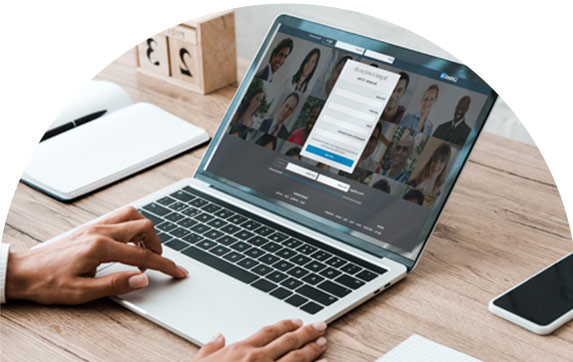LinkedIn is the social media platform of choice among professionals. The reason why is clear – it allows connecting with people in relevant industries all over the world. For B2B prospecting, it’s also a goldmine, allowing users to pinpoint potential prospects and generate B2B sales leads with the greatest of ease. However, there are limitations, rules, and etiquette in using the platform. If people aren’t in your network already, it can be hard to reach them. But it’s not impossible. We look at how to connect with someone out of your network on LinkedIn.
How do you connect on LinkedIn?
If you’re relatively new to the world of LinkedIn, you might be wondering how to communicate with people, especially those looking for B2B lead generation. Often, it takes an established network to be able to instantly connect with someone if you don’t already know them in person.
LinkedIn uses degrees of connection to determine who you can connect with when you find them in search. We’ll cover these in more detail further down. However, usually, you can send a request to people who are 1st- and 2nd-degree connections, as well as some 3rd-degree ones.
You can add people and personalize your message in a few ways:
- Directly on their profile by hitting Connect
- Through the search results page (no personalized message)
- By adding your email and using the Grow Your Network page
- Using the People You May Know feature
- Browsing profiles
What do 1st, 2nd, and 3rd mean on LinkedIn?
You’ll notice that on many profiles you come across, there will be a 1st, 2nd, or 3rd symbol next to the person’s name. This indicates how directly you are connected with them. This makes it much easier when find the right people to connect with.
Here’s what the degrees of connection mean:
- First degree (1st degree). These are people who you are directly connected with already. You may have accepted their invitation or sent one they’ve accepted. You can contact these people directly via the LinkedIn message tool.
- Second degree (2nd degree). People directly connected to your 1st-degree connections. With 2nd-degree connections, you can send an introduction or InMail to make them 1st-degree ones.
- Third degree (3rd degree). These are people who are connected to your own 2nd-degree connections. Again, you can send an InMail or introduction to make them closer to your network.
You’ll also see that some people don’t have a number next to their names. These people aren’t in your network at all and can only be reached with an InMail. However, there is a way around this. If you’re in the same group as someone, but they’re not in your network, you can still message them directly and then connect.
LinkedIn Etiquette
LinkedIn is an established platform that’s full of professional people. As such, there are certain unwritten rules and etiquette that you should follow. Remember, people use LinkedIn for work-related matters, not to catch up with friends.
Perhaps the most important point, particularly if you’re trying to fill the sales pipeline, is not to sell. At least, not overtly. You shouldn’t spam people when you’re sending a LinkedIn invitation message or trying to expand your connection network. It won’t work, and people don’t appreciate it.
So, you might be asking, ‘who should I connect with on LinkedIn?’ or ‘how to generate leads on LinkedIn?’ Well, the answer is relatively straightforward. Anyone, you think you can have a mutually beneficial connection with or have similar business interests. For many, this means co-workers, prospective clients, employers, and alike. For B2B salespeople, it’s people who will be receptive to and benefit from what you’re selling.
When you’re considering how to reach out to someone on LinkedIn, bear in mind the same principle. Don’t just cut and paste the same message to a bunch of random people. Hand-pick those you want to connect with and tailor a message toward them.
Personalize your message
A person’s LinkedIn profile should say everything you need to know about them (If yours doesn’t, check out our profile tips). This can be incredibly useful for someone trying for b2b sales lead generation on the platform.
As we mentioned, you should ensure your message is personalized when approaching a new connection. The person’s profile is the perfect inspiration for what to write. You should mention why you’re connecting, what you have in common, and why it could be mutually beneficial.
Personalizing your message makes you stand out from the crowd. It also means the person you’re reaching out to is more likely to accept.
Canceling a connection request
Of course, you might find that you send a request in error or later want to withdraw it. Thankfully, you can do so fairly easily. This includes connections to other members and to joining Pages or Events. There is a caveat – the recipient can’t have already responded.
Here’s how to cancel a connection request:
- Click on the ‘My Network’ icon.
- Navigate to ‘See all’ next to ‘Invitations.’ This takes you to the manage invitations page.
- Click on the ‘Sent’ tab. This will show you everything you’ve sent out.
- There is an option to ‘Withdraw’ next to the recipient’s name.
Once you’ve canceled a request, you won’t be able to send another invite to them for three weeks.
Conclusion
LinkedIn is one of the most powerful networking tools out there. It’s also fantastic for B2B lead generation service. However, you must know what you’re doing to make the most out of it.
If you want to make someone a first-degree connection, it might seem like they need to be a second-degree or third-degree connection. However, when it comes to connecting with someone out of your network on LinkedIn, you can send InMail to everyone. You can also message people who are in the same groups as you.
FAQs
- Should you connect with anyone on LinkedIn? You should only connect with people you know or share an interest with. Similarly, if you think the connection will be mutually beneficial.
- Why can I not connect with anyone on LinkedIn? You won’t see the Connect button if you haven’t confirmed your email, have already sent a connection request, or are already connected.
- What happens when you reach 1000 connections on LinkedIn? Nothing, LinkedIn doesn’t alter your profile or status based on your number of connections.
- Do LinkedIn requests expire? Yes, they expire after six months.
- Will someone know if I withdraw a LinkedIn invitation? No, they won’t be notified if you withdraw it. However, they may notice it was there before.

